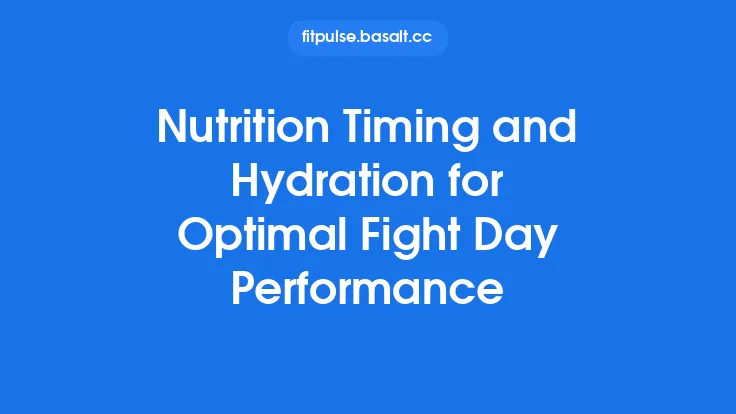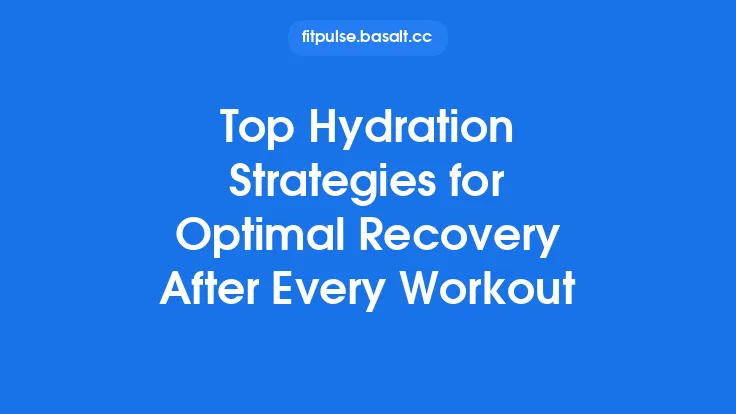Weightlifting places unique demands on the neuromuscular system, and even a modest shortfall in fluid balance can translate into reduced force production, impaired motor control, and a higher risk of injury. While the spotlight often shines on protein, calories, and training volume, the foundation of every successful lift begins with proper hydration. Below is a comprehensive guide to the science‑backed strategies that help strength athletes maintain optimal fluid status before, during, and after heavy training sessions.
Why Hydration Matters for Weightlifting Performance
- Cellular Volume and Muscle Tension – Muscle fibers are composed of roughly 75 % water. Adequate intracellular fluid preserves the turgor pressure needed for optimal cross‑bridge formation, directly influencing maximal voluntary contraction force.
- Neuromuscular Transmission – Electrolyte‑laden plasma is essential for the generation and propagation of action potentials. Even a 2 % loss in total body water can slow nerve conduction velocity, leading to delayed motor unit recruitment.
- Thermoregulation and Fatigue – Weightlifting often involves short, intense bouts that generate substantial metabolic heat. Efficient sweating and evaporative cooling depend on sufficient fluid reserves; otherwise, core temperature rises, accelerating perceived exertion and compromising technique.
- Joint Lubrication – Synovial fluid, a viscous plasma derivative, relies on adequate hydration to cushion articulations under heavy loads. Dehydration can increase joint friction, contributing to discomfort and reduced range of motion.
Physiological Effects of Dehydration on Muscular Function
| Dehydration Level | Primary Physiological Impact | Expected Performance Consequence |
|---|---|---|
| 0–1 % body mass loss | Slight increase in plasma osmolality; minimal electrolyte shift | Negligible effect for most lifters |
| 1–2 % body mass loss | Reduced plasma volume → lower stroke volume, higher heart rate | 2–4 % drop in peak power output |
| 2–3 % body mass loss | Impaired calcium handling in sarcoplasmic reticulum; decreased muscle contractility | Noticeable loss of bar speed, early onset of fatigue |
| >3 % body mass loss | Marked hyperosmolarity, significant electrolyte imbalance, compromised CNS function | Substantial decline in lift quality, increased injury risk |
Even the lower end of this spectrum can affect the fine motor control required for complex lifts such as the snatch or clean‑and‑jerk, where timing and precision are paramount.
Assessing Your Hydration Status
- Urine Color Chart – A pale straw color (U‑value 1–3) generally indicates adequate hydration; darker amber (U‑value 5–7) suggests a fluid deficit.
- Body Mass Changes – Weigh yourself nude before and after a training session. A loss of >1 % signals the need for immediate rehydration.
- Bioelectrical Impedance Analysis (BIA) – Offers a quick estimate of total body water, though accuracy can be affected by recent food intake and skin temperature.
- Thirst Perception – Not a reliable early indicator; by the time thirst is felt, a 0.5–1 % fluid loss may already have occurred.
Daily Fluid Requirements for Strength Athletes
The “8 × 8” rule (eight 8‑oz glasses) is a useful baseline, but weightlifters often need more due to higher sweat rates and larger muscle mass. A practical formula:
\[
\text{Daily Fluid (L)} = 0.033 \times \text{Body Mass (kg)} + \text{Exercise Fluid Loss (L)}
\]
Example: A 90 kg lifter with a measured sweat loss of 1.2 L during a 90‑minute session would target roughly:
\[
0.033 \times 90 = 2.97\text{ L} \\
\text{Total} = 2.97 + 1.2 = 4.17\text{ L/day}
\]
Adjust upward on hot days or when training in humid environments.
Pre‑Workout Hydration Protocols
- Baseline Rehydration (2–3 h before training) – Consume 500–600 mL of water or a low‑calorie electrolyte beverage. This allows time for gastric emptying and absorption.
- Top‑Off (15–30 min pre‑session) – Ingest an additional 200–250 mL of fluid, preferably with 150–200 mg of sodium to stimulate thirst and promote fluid retention.
- Avoid Excessive Volume – More than 1 L within 30 min can cause gastrointestinal discomfort and impair lift execution.
Intra‑Workout Hydration Strategies
Weightlifting sessions are typically intermittent, but sweat loss can still accumulate, especially during high‑volume or circuit‑style training.
| Duration | Recommended Fluid Intake |
|---|---|
| ≤30 min | 150–250 mL of water (optional) |
| 30–60 min | 250–350 mL of a 6–8 % carbohydrate‑electrolyte solution (if the athlete tolerates carbs) |
| >60 min | 350–500 mL of the same solution, split into 150–200 mL sips every 10–15 min |
For pure strength sessions where carbohydrate intake is not a priority, a low‑calorie electrolyte drink (≈30 mmol/L sodium) can be used to replace salts without adding unnecessary calories.
Post‑Workout Rehydration and Electrolyte Replacement
The goal is to restore fluid balance and replenish sodium, potassium, and magnesium lost in sweat.
- Calculate Fluid Deficit – Multiply post‑session body mass loss (kg) by 1.5 L (the 1.5 factor accounts for ongoing diuresis).
- Rehydration Beverage – A 6 % carbohydrate solution with 30–50 mmol/L sodium and 5–10 mmol/L potassium is optimal for rapid gastric emptying and electrolyte uptake.
- Timing – Begin rehydration within 30 min post‑session and continue for the next 2–3 h to ensure full plasma volume restoration.
Choosing the Right Fluids: Water vs. Sports Drinks
| Fluid Type | Ideal Use Case | Key Components |
|---|---|---|
| Plain Water | Low‑intensity or short sessions (<30 min) | 0 % carbs, 0 % electrolytes |
| Low‑Calorie Electrolyte Drink | Moderate sessions (30–60 min) in warm environments | 10–20 mmol/L sodium, minimal carbs |
| Standard Sports Drink (6 % carbs) | Long sessions (>60 min) or when carbohydrate intake is desired for glycogen sparing | 6 % glucose/fructose, 30–50 mmol/L sodium, 5–10 mmol/L potassium |
| Custom Electrolyte Powder | Athletes with specific sodium needs (e.g., heavy sweaters) | Adjustable sodium (up to 80 mmol/L) and potassium levels |
For pure strength training, the low‑calorie electrolyte option often provides the best balance between fluid retention and caloric control.
Special Considerations: Heat, Altitude, and Individual Variability
- Heat Stress – In ambient temperatures >30 °C, sweat rates can exceed 1.5 L/h. Increase sodium concentration to 60–80 mmol/L to offset higher salt loss.
- Altitude – At elevations >2,500 m, respiratory water loss rises. Aim for an additional 0.5 L of fluid per day and monitor for signs of acute mountain sickness.
- Sex Differences – Women generally have lower total body water percentages; adjust fluid targets by ~5 % lower than male counterparts of the same body mass.
- Training Age – Novice lifters may underestimate fluid needs; seasoned athletes often develop a personal “hydration fingerprint” based on years of trial and error.
Practical Tips for Implementing a Hydration Plan
- Carry a Marked Bottle – Use a 500 mL bottle with volume markings to track intake during warm‑up and rest periods.
- Set Reminders – Smartphone alarms or gym timers can cue you to sip every 10–15 min.
- Flavor Without Sugar – Add a squeeze of lemon or a few drops of natural flavor extracts to water to improve palatability without adding calories.
- Pre‑Pack Electrolyte Packets – Keep single‑serve sachets in your gym bag for quick mixing.
- Post‑Session Log – Record post‑workout body mass and fluid consumed; adjust future targets based on trends.
Common Mistakes and How to Avoid Them
| Mistake | Consequence | Corrective Action |
|---|---|---|
| Relying Solely on Thirst | Delayed rehydration, performance dip | Use objective measures (urine color, body mass) |
| Over‑Consuming Plain Water During Long Sessions | Hyponatremia risk | Include sodium‑containing fluids after 60 min |
| Skipping Post‑Workout Rehydration | Incomplete plasma volume restoration, prolonged fatigue | Follow the 1.5 × fluid deficit rule within 2 h |
| Using High‑Sugar Drinks for Short Sessions | Unnecessary caloric load, GI upset | Opt for low‑calorie electrolyte solutions |
| Neglecting Individual Sweat Rate Testing | One‑size‑fits‑all approach leads to under‑ or over‑hydration | Conduct a simple sweat test (weigh before/after a typical session) |
Monitoring and Adjusting Over Time
Hydration is not a static prescription; it evolves with training cycles, environmental changes, and physiological adaptations.
- Quarterly Sweat Tests – Repeat the pre‑ and post‑session weighing protocol every 8–12 weeks.
- Seasonal Review – Adjust sodium concentration in beverages during summer months or when training at altitude.
- Feedback Loop – Correlate lift performance metrics (e.g., bar speed, total volume) with hydration logs to identify patterns.
- Professional Consultation – For athletes with medical conditions (e.g., hypertension, kidney issues), involve a sports dietitian or physician to tailor electrolyte intake.
By treating hydration as a deliberate, data‑driven component of your strength training regimen, you create a stable internal environment that supports maximal force production, sharp neuromuscular coordination, and rapid recovery. Consistent application of the strategies outlined above will help you lift heavier, train longer, and stay healthier throughout your athletic journey.





